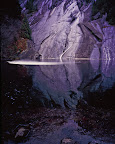
When we visited Ebey's Landing, we gave up on getting a sunset shot, because the weather was pretty nasty; it was getting cold and windy, and intermittently raining. While we ate dinner, the sky started clearing, so we decided to take a chance and stop at Deception Pass on the way back.
Since the tide was out, were able to explore some tidepools while waiting for the sunset. I found quite a few subjects in those tide pools, and also discovered how difficult it can be to photograph them.
These anemones were quite small; I had my macro lens nearly so close that the lens shade was nearly touching the water's surface. Of course, at that magnification, the light loss is pretty severe; in order to get some depth of field, I had this stopped down to around f/32. The tidepools were also in shadow, so even though the sky had cleared enough to let out the sunlight, I was still limited to a shutter speed of around half a second. So there is a little bit of motion blur in most of my images from that trip.

This one was relatively free of motion blur, though it was still very difficult to get the focus right. These anemones are also quite small; they were in the same little tide pool as the ones above, maybe 8 inches in diameter (that's 2oomm for those of you who are used to using a good system of measurement ;)).
There were a few barnacles that had their gills extended. It turned out that they were very sensititve; the slightest hint of a shadow falling across them was enough to make them retract their gills. I attempted to photograph them a few times, but every time I wound up making them retract their gills while I was trying to get the composition set up and focussed. Maybe I'll have better luck with them next time.
Technical Details
Since there may be some photographers reading this who are interested in how I shot these, I'm including a little technical info here.
Because I was trying to fill the frame with these small subjects, I was getting pretty close to them with my Nikon 105mm VR macro lens. To make up for the loss of depth of field, I was shooting at an effective aperture of f/32. The resulting shutter speed varied from 1/4 to a few seconds, so hand-holding the camera wasn't an option. I used a Really Right Stuff ground pod with a Really Right Stuff macro focussing rail. This helped a lot, because the tripod was small enough to be manouverable in the small area I had available, while my large Gitzo would have gotten in the way. The focussing rail gave me a bit of extra flexibility as far as positioning my camera, since I could use it like a rotated center column, a bit like the one on the Gitzo Explorer series tripods. The lead screw made focussing fairly easy once I had the composition set up.
Even with all that, setting up the composition was pretty tough. Some of the subjects I was photographing were very difficult to see without magnification, and in some cases just the glare on the surface of the water made them hard to see was underneath. For the same reason, additional lighting would probably not have done much good, so in spite of the slow shutter speeds, I didn't miss the extra lighting gear.
For some shots, there was still some glare from the sky reflecting in the water, and since I was shooting without a polarizer (I need to get a polarizer that will fit my dSLR lenses, the 105mm that I use for my large format is too unwieldy on a smaller camera, and it's also linear rather than circular), I had to shade the water with my hand while shooting. To avoid shaking the camera by pressing the shutter, I used the timer release since I don't (yet) have a cable or remote for my Nikon dSLR. In any case, with the shutter speeds being so slow already, using a polarizer might have backfired due to the potential for additional subject movememt. Even in these tiny tide pools, the water and the creatures continue to move. At least not all of them are as shy as the barnacles!
Setting up these shots was quite challenging. I'm glad I got a few decent shots, but it's going to take quite a bit more practice before I can get some great ones.




































